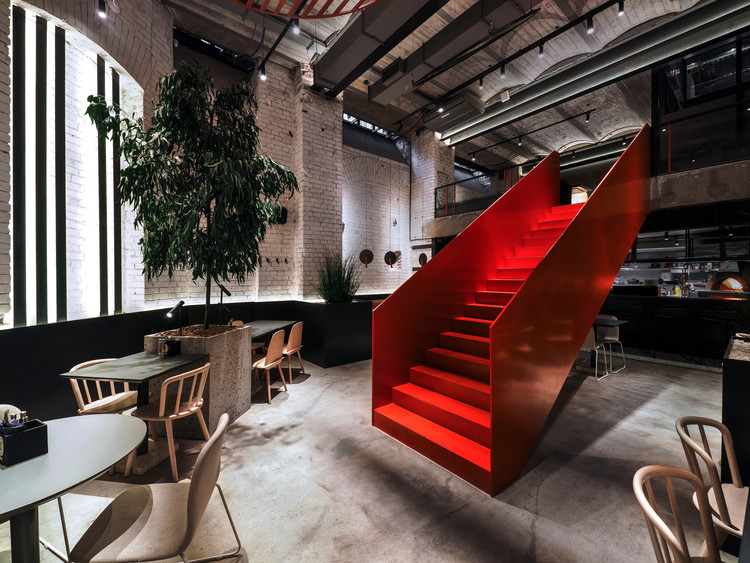OPEN Prototype for Temporary Sales Pavilion OPEN Architecture
2014-01-08 01:00
Text description provided by the architects. Design Concept
作为近年来中国独特的建筑类型,销售亭反映出了相当有趣的现象。在中国几乎所有的住房项目出售之前,一定要建一个售楼亭。虽然这些展馆建筑通常在形式和装饰上都很奢侈,但它们通常与实际销售和销售的房屋几乎没有任何关系。
As a unique Chinese architectural typology in recent years, sales pavilion reflects rather interesting phenomena. A sales pavilion will surely be built before the sales of almost every housing project in China. Extravaganzas as these pavilion buildings often are, in terms of form and décor, they normally bare almost no relationship to the actual housing marketed and sold inside.
这种建筑类型学一直是精英建筑师在中国实践的一个受人喜爱的试验场,提供了许多其他类型建筑所不喜欢的设计和预算自由。然而,由于临时建筑的诞生,这些昂贵的展馆往往在出售完成后不久就被拆除,在一些幸运的情况下,这些展馆被改建成其他功能。
This building typology has been a beloved experimental field for elite architects practicing in China, offering much design and budget freedom that most other types of buildings do not enjoy. However, temporary buildings as they were born to be, these costly pavilions are often demolished shortly after the sales were completed, and in some lucky cases, converted to other functions.
开放开始反思这些独特的现象,特别是资源的浪费和设计的努力。这成为西华福销售馆的起点,该展馆是开发公司万科集团标准临时销售展馆的原型V1.0。
OPEN started to reflect on these unique phenomena especially the wasted resources and design efforts. This became the starting point for Xihuafu Sales Pavilion which serves as prototype V1.0 of standard temporary sales pavilion for the development company VANKE Group.
与中国建筑研究院的工程师合作,开放式建筑设计了一个原型建筑系统,可以快速建造,可以适应不同的项目和地点,更重要的是,每次使用后都要拆开,然后在另一个地方重新组装。这座可再利用的建筑是一项试验,目的是检验可持续性的最终潜力,不仅在于其已实现的物理形式,而且还在于其生命周期的意义。
Working together with engineers from China Academy of Building Research, OPEN conceived a prototype building system that enables speedy construction, can be adaptable to different programs and sites, and more importantly, dissembled after each use and reassembled at another location. This re-useable building is an experiment to test the ultimate potential of sustainability, not only in its realized physical form, but also the meaning in its life cycle.
这个原型是受中国古代木结构的启发,这些木结构可以被拆开,重新组合在一起,有时是在不同的地方。由一个模块化系统设计,钢结构骨架,以及由钢和混凝土制成的复合楼板,在现场预制和螺栓连接在一起。
This prototype was inspired by ancient Chinese wooden structures that can be taken apart and put together again, sometimes at a different locale. Devised from one modular system, the steel structural skeleton, and the composite floor panels made from steel and concrete, are prefabricated and bolted together on site.
模块化概念延伸到建筑外壳-固体铝板和玻璃面板都采用相同的模块,这样就可以根据后面不同的程序要求,在门面上自由布置开口。
The modular concepts extends to the building envelope – both the solid aluminum panels and the glass panels take on the same module, which allows a somewhat free arrangement of openings on the façade according to different program requirement behind.
在内部,这个空间是由一座桥组成的,它连接着5个盒子,每个盒子都包含不同类型的功能,同时允许一个大的连续开放空间来组织公众观看和活动。内部装饰可以不同,以及五个盒子的位置。在这种情况下,一个最小的,但色彩丰富和未来主义的气氛被创造出来,以对抗共同的期望,豪华,但往往是妥协的空间,公众用来看到他们周围。
Internally, the space is organized with one bridge that connects 5 boxes that each contains different types of functions, yet allowing a large continuous open space to organize the public viewing and events. The interior décor can vary, as well as the positions of the five boxes. In this built case, a minimal yet colorful and futuristic atmosphere is created to counter the common expectation for the luxurious yet often compromised spaces that the public is used to see around them.
从外面看,展馆是一根简单的水平银管,漂浮在一片水之上,这让人想起了上世纪60年代的实验太空胶囊。参观者通过倒影池上方的一座高架桥接近大楼,从大管道的一端进入展馆,穿过内部不同的功能空间,然后在管道的另一端出口,然后走向展厅后面。
The pavilion presents itself from the outside as a simple horizontal silver tube floating above a sheet of water, recalling 1960s’ experimental space capsules. The visitors approach the building through a rising bridge over the reflecting pond, entering the pavilion from one end of the large tube, through the different functional spaces inside, exit on the other end of the tube, before they walk towards the show-flat behind.
这个临时的销售展馆提供了一个开放的机会,第一次意识到,他们的概念和大规模定制的实验开始于10年前在纽约市形成的开放式建筑工作室,如生态管和XYZ住宅工程。
This temporary sales pavilion offers an opportunity for OPEN to realize for the first time, their concept and experimentation on mass-customization started almost 10 years ago in New York City in the forming years of OPEN Architecture Studio, such as the eco-tube and XYZ housing works.
 举报
举报
别默默的看了,快登录帮我评论一下吧!:)
注册
登录
更多评论
相关文章
-

描边风设计中,最容易犯的8种问题分析
2018年走过了四分之一,LOGO设计趋势也清晰了LOGO设计
-

描边风设计中,最容易犯的8种问题分析
2018年走过了四分之一,LOGO设计趋势也清晰了LOGO设计
-

描边风设计中,最容易犯的8种问题分析
2018年走过了四分之一,LOGO设计趋势也清晰了LOGO设计






































































































